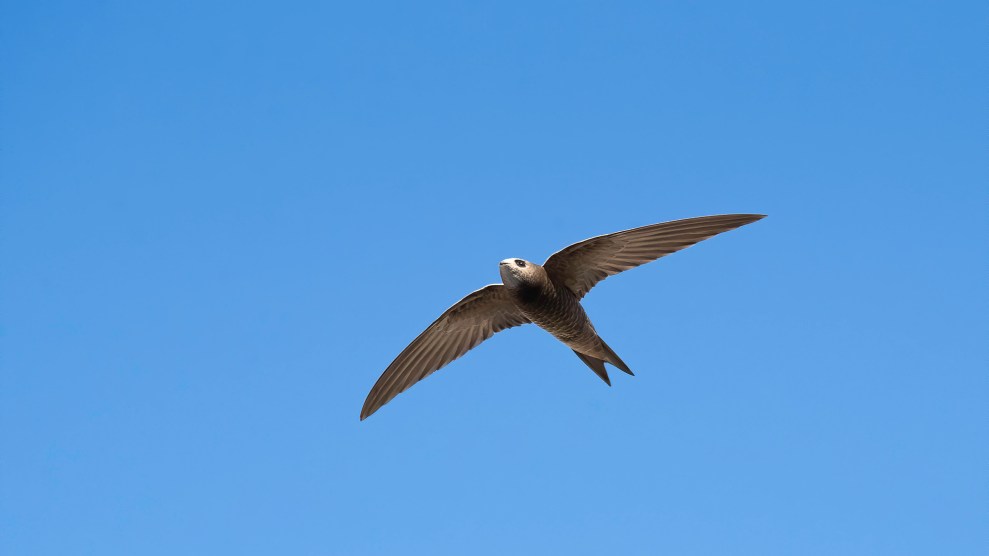
"They are terrific birds."Cero De Simone/ Getty Images
This story was originally published by the Guardian and is reproduced here as part of the Climate Desk collaboration.
Retired salesman John Stimpson just turned 80. He celebrated the occasion with a cake at Slimming World, followed by dinner with his family. Stimpson had one achievement in particular to mark: He has just completed his goal of building 30,000 swift boxes, which could house half of the UK’s breeding population of 60,000 pairs.
Stimpson has been making these peculiarly shaped boxes for 13 years using three saws and three drills in his garage attached to his bungalow near Ely in Cambridgeshire. What started as a retirement hobby morphed into a full-time job after orders increased, and he sometimes works 13-hour days to get them all done. He sells them for £20 (about $27), which is enough to cover his costs.
He has also made about 700 boxes for barn owls and 800 for blue tits, finches, blackbirds, and thrushes. According to the British Trust for Ornithology, a high percentage of swift boxes put up in the UK have been made by Stimpson. It wasn’t until he went through his order book last July that he realized quite how many he’d made.
“I don’t get bored. It’s amazing the number of life problems that have been solved in this garage. Your mind thinks over things,” he says. He hopes he will still be making the boxes when he is 99 (the age his mother is), but his pace will probably slow.
It is estimated that half the human-made nest boxes in the UK are inhabited, so Stimpson has probably housed 15,000 pairs of swifts. He talks about his achievement with modesty. “It’s a nice thought,” he says. “I’m quite proud of it at the end of the day. After failing academic exams in the 50s, I feel I’ve made a mark.”
Stimpson retired early, after working as a Weetabix salesman for 20 years then selling horticultural labels at Burall Bros for another 19. He has lived in the village of Wilburton for 51 years with his wife, Jill. He says it was thanks to his grandfather—who was a farm worker—taking him out that he learned to love nature. “I get so much pleasure from wildlife. Building these boxes is one way I can pay it back.”
Like many people, Stimpson has noticed an alarming loss of wildlife in his lifetime. The clouds of swifts, swallows, and house martins of his childhood have disappeared. He feels angry that his two granddaughters cannot enjoy the abundance of the past.
A loss of nesting sites is driving the decline of swifts in the UK, whose numbers are believed to have dropped by about 57 percent in 22 years. These migrants—which are now on the UK’s red list—are site specific, meaning each spring they come back to the same spot after flying thousands of miles from Africa. The problem is that lots of old barns and draughty houses have been upgraded and patched up and nesting sites have disappeared.
In spring, swifts screech when trying to find a place to nest and attract mates. Some birds will frantically flap their wings in vain, trying to find their old nesting spot. “To hear these birds screaming is quite distressing,” says Stimpson. “There’s no need for it. We can have our houses airtight, but we can still make homes for them,” he says.
Thirteen years ago no one was making swift boxes, so Stimpson started. “I’m not a carpenter, I’m a salesman, but I thought I’ll certainly give it a go,” he says. When he started he could make three a day, now on a really good day he can make 30. “I still want to make as many boxes as I can. I don’t like letting people down. My word is my bond,” he says. His boxes have been sent all over the UK, as well as to Sweden, France, Spain and Italy, and his computer is full of pictures of swifts in his boxes from grateful recipients.
Government and big wildlife organizations have too much bureaucracy, says Stimpson, and don’t end up doing much to stop wildlife loss. “We seem to have too many pen-pushers and not enough workers,” he says. “We could do an awful lot more than we’re doing. I don’t care if it’s Tory, Labour, Liberals or the Monster Raving Loony party. They need to address this.”
He believes local action groups are much more effective and has been working with a number of them, including the Suffolk Bird Group, who run Save our Suffolk Swifts (SOS Swifts), and Action for Swifts. “The number of swift groups that have started up in the last five to eight years is quite staggering. And they seem to go from strength to strength,” he says.
Volunteers want to emulate the success story of barn owls. In 1987, these farmland birds were at their lowest ebb with 4,500 breeding pairs. Thanks to volunteers, today there are about 12,000 breeding pairs in the UK, with 80 percent living in human-made boxes.
There are small success stories all over the country. Eddie Bathgate noticed Suffolk’s swift population crashing in the 1990s and 2000s, so he set up SOS Swifts in 2016. Now there are more than 1,200 of Stimpson’s boxes around the county, including 120 in Bathgate’s hometown of Woodbridge, 27 of which hosted nesting pairs last summer.
In Cumbria, volunteers from Sedbergh Community Swifts have put up 140 boxes, all made by Stimpson, except for seven, which were copies made by local schoolchildren. An ad hoc survey of 99 boxes last summer found 46 percent of them were occupied.
“Swifts are the one thing where an individual can make a significant difference,” says Dick Newell, from Action for Swifts, who has 66 pairs of nesting swifts in his village of Landbeach in Cambridgeshire, 20 of them nesting on his house. “They are terrific birds. I’ve been an engineer. I like problem solving, and these birds present so many problems that we can solve.”
Newell says developers should be obliged to put a swift brick in every new-build, and he has been working with housebuilding company Taylor Wimpey to make this happen. Exeter city council has started incorporating them into new buildings, as well as the Duchy of Cornwall, and local councils are getting on board. Others are working on bee bricks and hedgehog holes in new developments.
“John Stimpson has provided space for nature on a scale that I don’t know if anyone else has done, and he’s nearly 80,” says Bathgate. “We have to hope that someone will step into his shoes, although I don’t think he has any plans for retirement.”













